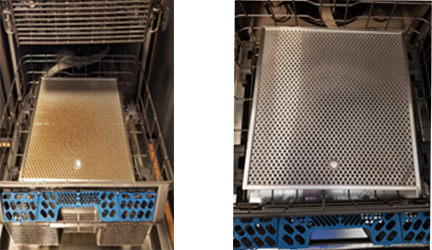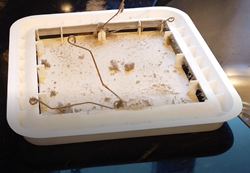Think Spring Refresh
Regular cleaning can significantly reduce dust, pollen, mold, and pet dander in the air. Daily vacuuming with a high-efficiency vacuum and regularly disinfecting surfaces are crucial. Don't forget often-overlooked areas like bathroom fans and range hoods. However, be mindful that cleaning chemicals can greatly impact indoor air quality (IAQ). To minimize this, avoid using harsh chemicals. If you must use them, ensure proper ventilation by opening windows or using exhaust fans.
Our kitchens are getting more use than ever, and they are the number one source of indoor air pollution. The range hood is your friend when it comes to keeping the air fresh and clean in your home! Run the kitchen range hood before, during, and after cooking to remove smoke, grease, moisture, and other airborne pollutants. While cleaning out your kitchen pantry, remember to wash your range hood filters as well. If you want to learn more about range hoods and IAQ, read more now.
How to Properly Clean Your Range Hood Filter:
- Sink: Soak your filters in hot, soapy water and scrub them as you would a pot or pan. For stubborn grease, add a bit of de-greaser or ammonia to the water. Keep in mind that cleaning chemicals can significantly affect IAQ. To reduce this impact, try to avoid harsh chemicals. If you need to use them, make sure to ventilate the area well by opening windows or using exhaust fans.
- Dishwasher: Most grease filters are dishwasher safe. Place filters into an empty dishwasher, add dishwashing detergent, and run on a heavy-duty cycle for best results.
Note: Some range hood filters are not designed to be cleaned. In such cases, it's best to purchase new filters. Consider setting up our subscribe and save program to receive new filters regularly and ensure your range hood is always functioning optimally.
Before: After:
Bathroom Fans
Having too high or too low indoor humidity can cause irritation to your nose and eyes and can be harmful to your home. Excess moisture can promote the growth of bacteria, mold, and viruses, worsening allergies and damaging your home. Cleaning or updating your bathroom fan can help lower humidity and prevent mold and mildew, which could lead to health issues if left untreated.
How to Properly Clean Your Bathroom Fan:
- Vacuum: With the grille removed, take a vacuum wand and suck up any accumulated dust on the inside of the housing.
- Sink: Most bathroom fan covers can be removed by detaching them from the springs in the ceiling fan. Wash the cover in warm, soapy water and wipe off the fan itself. Once clean, reattach the cover
Whole House Humidity
While there can be moisture in your bathroom, don’t forget to check the whole house for moisture as well! Moisture is often present in laundry rooms, mudrooms, and home gyms. Mildew thrives in humid environments. Keep a healthy balance of humidity in your home by installing ventilation fans in humidity-prone rooms and an Energy Recovery Ventilator (ERV) fresh air system. An ERV can balance humidity while bringing in fresh, filtered air and removing stale, dirty air.
HVAC & Vacuuming
As we embrace the season of renewal, it's the perfect time for a spring refresh, and that includes ensuring your HVAC system is in top shape. A critical component of this is the furnace filter, which plays a vital role in maintaining indoor air quality (IAQ). Regularly replacing your HVAC filter helps trap dust, allergens, and pollutants, contributing to a healthier home environment. For those looking to achieve the highest level of air purification, HEPA filters are an excellent choice, as they can remove up to 99.97% of particles as small as 0.3 microns. Additionally, the vacuum you use can significantly affect the air quality in your home. Many handheld vacuums recirculate air inside your home, which can affect indoor air quality (IAQ). Smart home vacuums, such as Roombas offer a convenient and efficient way to maintain cleanliness. Proper maintenance of these devices includes regular emptying of dustbins, cleaning of filters, and checking for blockages to ensure optimal performance. These vacuums often come with HEPA filters that help improve IAQ by trapping fine particles, but regular upkeep is essential to maintain their effectiveness.
Next time you’re doing some spring cleaning, make sure you follow these simple tips to keep the air in your home fresh.

 English
English
 English
English

